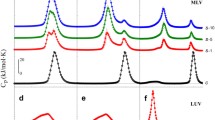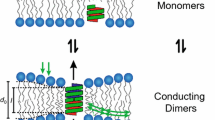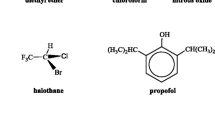Abstract
A longstanding and unresolved problem in general anaesthesia is the so-called ‘cutoff’ effect; as one ascends a homologous series of anaesthetic agents, the potencies progressively increase with anaesthetic size but then, rather suddenly, anaesthetic potency disappears1–5. Curiously, this cutoff in potency occurs at very different points in different series. Various explanations have been offered5,6, usually based on the notion that lipid bilayers are the primary target sites in general anaesthesia3,4,7. However, accumulating evidence now suggests that proteins are the primary sites of action8–14. Here we demonstrate cutoff effects for the anaesthetic inhibition of a soluble protein (firefly luciferase) which mirror those found for general anaesthesia, and we describe how the molecular architecture of the binding site accounts for the different cutoffs in the different homologous series. We show that this behaviour is a natural consequence of anaesthetics binding to an amphiphilic protein pocket of circumscribed dimensions. When general anaesthetic target sites in animals and the luciferase protein are mapped out using the fine details of the potency data, remarkable similarities are revealed. Our results thus suggest that the target sites in general anaesthesia are amphiphilic pockets on proteins.
Similar content being viewed by others
References
Meyer, K. H. & Hemmi, H. Biochem. Z. 277, 39–71 (1935).
Gary-Bobo, C. & Lindenberg, B. A. C.r. hebd. Séanc. Acad. Sci., Paris 234, 2111–2113 (1952).
Mullins, L. J. Chem. Rev. 54, 289–323 (1954).
Pringle, M. J., Brown, K. B. & Miller, K. W. Molec. Pharmac. 19, 49–55 (1981).
Mullins, L. J. in Alterations of Chemical Equilibrium in the Nervous System (ed. Lajtha, A.) 395–421 (Plenum, New York, 1971).
Ferguson, J. Proc. R. Soc. B127, 387–404 (1939).
Haydon, D. A., Hendry, B. M., Levinson, S. R. & Requena, J. Nature 268, 356–358 (1977).
Adey, G., Wardley-Smith, B. & White, D. Life Sci. 17, 1849–1854 (1976).
Middleton, A. J. & Smith, E. B. Proc. R. Soc. B193, 173–190 (1976).
Franks, N. P. & Lieb, W. R. Nature 274, 339–342 (1978).
Richards, C. D. et al. Nature 276, 775–779 (1978).
Franks, N. P. & Lieb, W. R. Nature 300, 487–493 (1982).
Smith, E. B. et al. Nature 311, 56–57 (1984).
Franks, N. P. & Lieb, W. R. Nature 310, 599–601 (1984).
Stein, W. D. Transport and Diffusion Across Cell Membranes (Academic, New York, 1986).
Tanford, C. The Hydrophobie Effect 2nd edn (Wiley, New York, 1980).
Requena, J. & Haydon, D. A. Biochim. biophys. Acta 814, 191–194 (1985).
Wilhelm, E., Battino, R. & Wilcock, R. J. Chem. Rev. 77, 219–262 (1977).
Bell, G. H. Chem. Phys. Lipids 10, 1–10 (1973).
Brink, F. & Posternak, J. M. J. cell. comp. Physiol. 32, 211–233 (1948).
Author information
Authors and Affiliations
Rights and permissions
About this article
Cite this article
Franks, N., Lieb, W. Mapping of general anaesthetic target sites provides a molecular basis for cutoff effects. Nature 316, 349–351 (1985). https://doi.org/10.1038/316349a0
Received:
Accepted:
Issue Date:
DOI: https://doi.org/10.1038/316349a0
- Springer Nature Limited
This article is cited by
-
The adenosine transporter, ENT1, in cardiomyocytes is sensitive to inhibition by ethanol in a kinase-dependent manner: implications for ethanol-dependent cardioprotection and nucleoside analog drug cytotoxicity
Purinergic Signalling (2014)
-
General anaesthesia: from molecular targets to neuronal pathways of sleep and arousal
Nature Reviews Neuroscience (2008)
-
Concentration-detection functions for eye irritation evoked by homologous n-alcohols and acetates approaching a cut-off point
Experimental Brain Research (2007)
-
The effect of dimyristoylphosphatidylethanol on the lateral and rotational mobilities of liposome lipid bilayers
Archives of Pharmacal Research (2005)
-
Straight‐chain alcohols exhibit a cutoff in potency for the inhibition of recombinant glutamate receptor subunits
British Journal of Pharmacology (2001)





